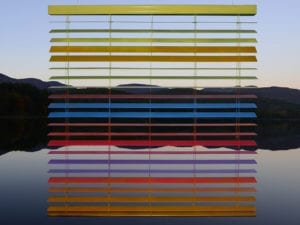We enter the world of technology in our 5 To See for 19-21 May. In line with Photo London‘s celebration of photography at Somerset House, we take a look at some of the leading practitioners who are pushing the boundaries on this highly-adaptable art form. In Reykjavík, Berg Contemporary highlights duo Steina & Woody Vasulka’s experimentation with electronic imaging since the 1970s, while Fondation Cartier examines the impact of the automobile on the work of internationally recognised photographers. Back in the UK, Mat Collishaw’s new immersive installation, Thresholds, uses the latest virtual reality technology to remind contemporary viewers of Fox Talbot’s pioneering image-making methods in the 19th century. We consider the photo-realist paintings of Jan Worst and include Daniel Buren’s newest spacial interventions.
1. Jan Worst, Interiors, Ben Brown Fine Arts, Hong Kong
The first solo exhibition of paintings by Jan Worst comes to Hong Kong. As a meticulous and methodical painter, Worst typically produces four large-scale works a year. On this occasion, the gallery brings together a selection of pieces created over the last 20 years, which showcase the artist’s dedication to a serial depiction of subject matter, painterly skill and highly charged and provocative imagery. Portraying lavish interiors and focusing on ornamental details such as the tapestries, gilded mouldings, chandeliers, antiquities and elaborate table settings, Worst’s paintings often feature a young woman, adding a sense of voyeurism to his oeuvre.
2. Steina & Woody Vasulka, Berg Contemporary, Reykjavík
An extensive selection of video works and electronic images by artistic couple Steina & Woody Vasulka are on display at Berg Contemporary. Following their encounter in Prague in 1962, they married and moved to New York, where, in 1971, they founded the experimental group, Perception, together with Eric Segal, obtaining a grant from NYSCA, the New York State art council, which allowed them research the evolution of multimedia. This led to the development of their respective individual aesthetical styles, which effortlessly marry the disciplines of art and technology. Berg Contemporary showcases historically important prints and video works by both individually.
3. Daniel Buren, To Align: works in situ, Bortolami, New York
Bortolami opens the artist’s fourth exhibition with the gallery, and the first in its new Tribeca location. Buren transforms the space using both coloured filters and new in situ works. Throughout his 50-year career, he has been known for his use of contrasting stripes as a visual tool that reveals the specific features and dimensions of a site. He alters the perception and context of one’s surroundings by modifying the navigation of space, enhancing lighting, obstructing viewpoints and highlighting architectural features. The sign of white and colour alternating stripes of exactly 8.7 cm. in width, as derived from the fabric he first used as a canvas in 1965, is a prominent component in the exhibition.
4. Mat Collishaw, Thresholds, Somerset House, London
Working in collaboration with Blain|Southern Gallery, Somerset House unveils new virtual reality artwork, Thresholds, by Mat Collishaw during Photo London. The artist restages Fox Talbot’s pioneering 1839 exhibition of photography with the aid of the latest VR technology. Through Collishaw’s careful digital reconstructions, viewers are able to travel back in time to the moment when British scientist William Henry Fox Talbot first presented his photographic prints to the public in Birmingham. Here, he aims to inspire a similar sense of wonderment for a present-day audience using VR, the most cutting-edge visual technology available today. Tickets for Thresholds can be purchased at online. The exhibition runs until 11 June.
5. Autophoto, Fondation Cartier, Paris
Fondation Cartier once again focuses on the world of cars with the exhibition Autophoto. Staged 30 years after Hommage à Ferrari, this new presentation revisits photography’s relationship to the automobile; how the car provided photographers with a new subject, a new point of view and new way of exploring the world. A total of 500 works created by 100 historic and contemporary artists from around the world including Jacques-Henri Lartigue, Lee Friedlander, Rosângela Renno and Yasuhiro Ishimoto adorn the interior of the Fondation Cartier to examine how the automobile has reshaped our landscape,
extended our geographic horizons and altered our, and notably artists’, concept of space and time.
Credits
1. Luciano Rigolini, Tribute to Giorgio de Chirico, 2017. Appropriation (unknown photographer, 1958). Collection of the artist. © Luciano Rigolini.




